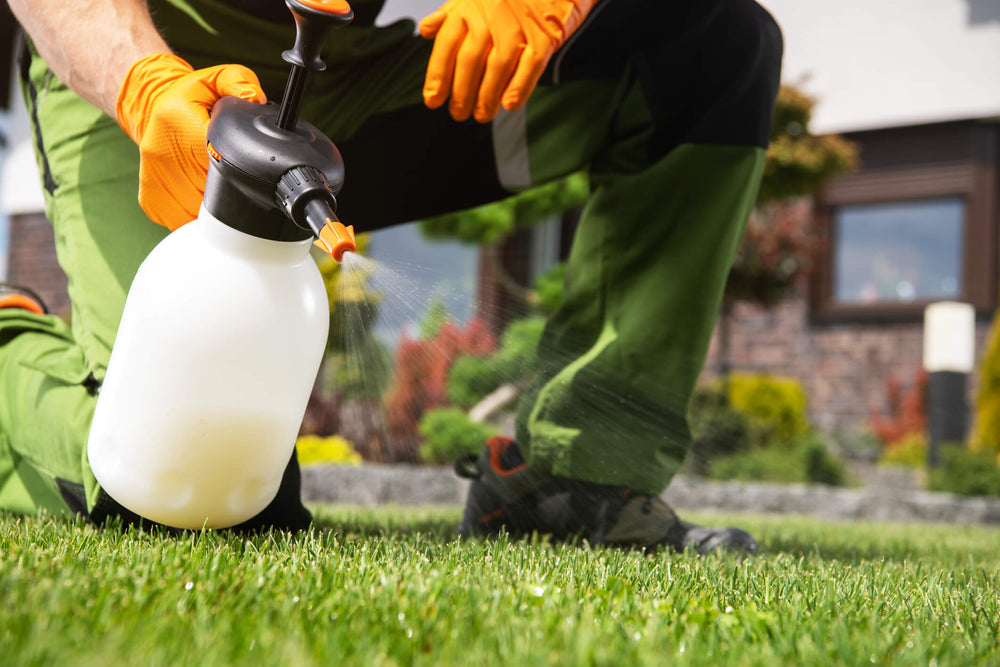While insects and pests are pieces of nature, they can wreak havoc on your lawn, garden, pets, and children. Controlling these pests all over your lawn is not always an easy task, but it can be accomplished by one of a few methods. Safely controlling the creatures in your yard is the best way to ensure a lush and healthy lawn. In this article, you can learn what damage pests can deal to lawns, what draws them to your yard, and ways to control them in the safest way possible.
Signs of lawn pest damage
While many types of pests can infiltrate a lawn, they often deal similar damage to the growth and look of a lawn. Some signs of pest damage can be the result of another problem, such as insufficient watering, but the source of the damage can be assessed by looking for the pests themselves. Pest damage is often found in more distinct shapes than other types of lawn problems. The following are common signs of pest damage in your lawn:
- Dry patches. Dry patches of grass typically signal that the roots of your grass are being eaten by pests beneath your lawn’s surface.
- Discolored patches. When pests feed on your lawn, they kill grass in patches and turn these areas yellow and brown. However, grass can sometimes exhibit other colors. For example, chinch bugs, commonly found in the eastern and midwestern United States, can turn patches of grass purple before yellow and brown.
- Small holes. Small holes can be a sign of many different types of creatures ranging from bees to squirrels. If holes are from ground-nesting bees or wasps, carefully mow around the areas to avoid agitating the nest.
- Irregular growth patterns. Pests that feed on grass can cause some patches to grow slower than others.
- Dirt mounds. Dirt mounds, like holes, are the result of a critter burrowing or digging. As these creatures dig, they leave behind mounds of dirt above ground.
- Ant hills. Ant hills are an obvious sign of ant infestation in your yard. Fire ants are a particularly nasty pest to deal with.
What attracts lawn pests?
Many natural and man-made objects can attract pests and insects to your lawn. However, you can take steps to eliminate each of these threats in your yard and around your home.
Long grass
If you do not regularly mow in the spring and summer, your grass will eventually sprout weeds and attract pests. It is best to mow your lawn about once per week during the growing season. Outside of growing season, you can cut back to mowing once every other week.
Weeds
Weeds are not only an eyesore, but they are also a food source for pests, insects, and larger wildlife. Other unwanted plants, such as dandelions, crabgrass, and ivy, can also attract pests to your lawn. When pulling weeds in your lawn, ensure you pull out the entire root system, not just the weeds sticking up in your lawn.

Debris
Any debris left lying around your yard can be seen as suitable nesting material for many types of creatures. Wood piles, leaves, and long grass often house moisture, opening an invitation to nearby pests. To prevent pests, insects, and small animals from invading your lawn, mow your lawn regularly and keep your yard clear of loose debris.
Trash cans
Trash cans are one of biggest attractions to both large and small creatures. Food odors are more than enough to attract critters to your home. This stresses the importance of properly tying your trash bags, ensuring your trash can’s lid remains tightly closed, and keeping your trash can in an indoor location, such as a garage, if possible. If you must store your trash container outdoors, ensure your bags are tied off completely and that your lid is closed tight.
Outdoor lights
Outdoor lights installed in high areas attract insects to your outdoor spaces. Bugs are attracted to lights in their flight path, so lights lower in your outdoor areas are less likely to draw unwanted insects. If your current lighting setup is drawing more bugs than you would like, consider spacing out the lights further apart and moving them closer to the ground.
Stagnant water
Standing water, such as in birdbaths and rain puddles, is a major attraction to mosquitoes and roaches. Stagnant water plays home to many types of bacteria, all of which attract unwanted creatures. The warmer the weather, the more pests will be attracted, and the more affected your lawn will be. Mosquitoes can lay eggs in water that is as shallow as ½ inch. Regularly changing your birdbath or other outdoor water and ensuring water does not have places to puddle can safeguard your home from all types of pests.
Clogged gutters and downspouts
Clogged gutters and downspouts serve as a breeding ground for mosquitoes and gnats because of the standing water caused by a blockage. Ensure you regularly clean out your gutters and downspout filters to prevent stagnant water from building up each rainfall. If you have not already done so, consider installing downspout filters or gutter guards in your home. Once installed,
Learn more: Types of downspout filters | How to prepare your gutters for fall

Clutter
Piles of wood, containers, bags, or other types of clutter near your yard are sure to attract pests to your lawn and home. Depending on the materials present, pests can be attracted for a variety of reasons. If food items are present in the clutter, insects, bugs, larger animals, and other critters will attempt to claim some of the food supply. Non-food items can still be used for nesting by a variety of species, so keeping any indoor or outdoor containers sealed is essential in preventing pests from infiltrating your lawn and home. Avoid using cardboard or wooden boxes, as these can easily be chewed through by critters, pests, and rodents.
How to best control lawn pests
Routine maintenance to your lawn is helpful at deterring pests, but it is best paired with a pest control solution. This solution for one home may look very different from another depending on what is already installed. For example, homes with an irrigation feeder system can incorporate a pest control formula with their system. Homes without these systems must follow a more traditional approach, such as pesticides and manual fertilization.
Regular maintenance
One of the most effective ways to deter insects and pests from your yard is by keeping a neatly kept lawn. This includes regular mowing, appropriate watering, and routinely clearing the lawn of debris.
Mow regularly
In the spring and summer, it is best to mow your lawn once every 7 to 14 days. During peak growing season, your lawn should be cut about once per week, while you can get by with mowing once every other week during slower growth months. Keeping grass blades short prevents hidden paths for critters to develop, prevents moisture from building up, and hinders weed growth.
Avoid overwatering
Too much water in your lawn creates a breeding ground for mosquitoes, while too little water makes your lawn unhealthy and brown. Most types of grass should receive about 1 to 1.5 inches of water each week. This equals about two sessions of 30 minutes waterings each week from an average sprinkler. If your lawn receives rainfall, cut back your manual watering to ensure your lawn receives the correct amount of water each week.
Learn more: A guide to watering your lawn
Clean gutters and downspouts
As a baseline, gutters and downspouts should be cleaned at least twice each year. If your home has many trees that drop leaves, twigs, pecans, acorns, or other types of debris on your home regularly, you will need to clean your gutters and downspouts much more often. If you do not have gutter guards or downspout filters installed on your home, consider doing so. These devices not only prevent your gutters from clogging, but they also prevent mosquitoes and other insects from breeding inside your gutters.
Clear debris
If your yard has trees, your yard undoubtedly gets covered in leaves and twigs regularly. While this is unavoidable, regularly clearing the debris left by your tree can prevent pests from invading your lawn. Trees naturally attract many types of insects and other wildlife, but keeping their byproducts off your lawn can prevent the migration of many types of bugs from your trees to your lawn.
Using pesticides
Pesticides control the population of insects around where they are sprayed. Some pesticides offer a chemical solution to pest control, while others offer more natural formulas like essential oils. Natural pesticides are not only more environmentally friendly as they seep into the soil, but they are also safer around children, pets, and adults. Regardless of the pesticide you choose, there are a couple methods of applying pesticides to your lawn.
Irrigation feeder systems
Irrigation feeder systems are the most expensive type of lawn watering, pest control, and fertilization systems, but they are also by far the most convenient. Irrigation systems utilize a series of underground pipes and sprinklers that make watering a lawn a breeze. A feeder system attaches to an irrigation system, dosing appropriate amounts of formula to spread across the lawn whenever it is watered. For example, an insect and pest repellant can be fed into an irrigation system and coat your entire lawn in pesticide. Many of these products, such as Nature Shield by American Hydro, are made from essential oils, providing a non-toxic, child-safe, and pet-safe solution to lawn pest control.
Hose end sprayers
Hose end sprayers are manually controlled devices that allow you to precisely control where pesticide is placed. Bottles of pesticide attach to hose end sprayers, where water and the formula are mixed at the time of spraying. The application rate of pesticides differs by product, so check your product’s instructions on the correct settings for your specific product with the hose end sprayer.

Granules
Granular pesticides and herbicides apply to the top of the lawn to kill weeds and insects on contact. These can be spread either by hand or by a spreading device. The granules take about 24 hours to dissolve, so most products warn to keep children and pets off the treated area for the same amount of time. After they dissolve, granular pesticides and herbicides continue killing pests or weeds for about three months.
